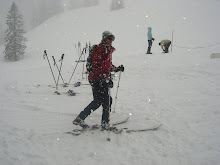
This year I helped Tyler work on a more permanent snow cave up near Cameron Pass in the Pudre Canyon on north-central Colorado. He picked a great location, tucked away in an alcove valley between a summer use road and highway 14 (Pudre Canyon Highway). Situated at 9,200 ft. and facing north, the snow pack near the cave is nice and deep, as evidenced by the fire Tyler built:
 Shortly after this photo was taken, we cut blocks out of the hard-packed snow and made the entrance much narrower. To make blocks, one must first find suitable snow and cut them out with a small-toothed saw. Snow blocks are brilliant building materials when made properly and essentially are the basis for igloos made by the Eskimo. Often, sutiable snow is difficult to find, so one must pack it down with snow shoes. The best place to look is the leeward side of trees on the edge of a clearing, where the snow has drifted. Game trails are often nearby, good place to set some snares for snowshoe hares.
Shortly after this photo was taken, we cut blocks out of the hard-packed snow and made the entrance much narrower. To make blocks, one must first find suitable snow and cut them out with a small-toothed saw. Snow blocks are brilliant building materials when made properly and essentially are the basis for igloos made by the Eskimo. Often, sutiable snow is difficult to find, so one must pack it down with snow shoes. The best place to look is the leeward side of trees on the edge of a clearing, where the snow has drifted. Game trails are often nearby, good place to set some snares for snowshoe hares.I am sure you are wondering how gear is brought from the car to the igloo, well with childrens' play sleds! A rope is tied to the sled and to ourselves and the sled is dragged:
 Yes, that is a snowboard attached to Tyler's rucksack.
Yes, that is a snowboard attached to Tyler's rucksack.You might be wondering, how do you keep yourself off the snow when you sleep? The key is to put as many layers and air space between you and the cold snow/ground as possible. In our shelter a tarp was put down first to cover the entire floor, then closed-cell foam pads, then (in my case) a Slumberjack self-inflating air mattress, a Z-rest closed-cell foam pad and finally a fleece blanket wrapped around the whole package. As you can tell, that is a lot of layers! A surprisingly large amount of heat is lost through your back while you sleep though.
You also might be wondering, what about keeping warm when not in the sleeping bag? Well, you stay moving around! That is why we dress in layers, allow me to elaborate. The layer closest to your skin is called the base layer, it is typically a high-performance, thing layer that acts to wick away moisture from your body to the next layer. The next layer is also synthetic and serves to keep pulling the moisture to your outer layer, this layer is typically fleece, but wool is also suitable. The last layer is usually the shell, serving to repel moisture, but yet allow some perspiration to get outside (hance Gore-tex). In essence, the key is to always be dry, because; dry = warm! NEVER wear cotton products, they do not keep you warm when you get wet!

A final departing shot of us packing the cars, Tyler back to Fort Collins and me to California (I drove through some nasty snow all the way to Salt Lake City, to arrive at 3:30am!). The plowed snow bank behind the cars is bigger than it looks! It took me an hour to get out of there, Tyler finally had to pull me with my tow strap! The whole time I had snow wires in my trunk, DUH! Oh well, you live and you learn. This blog was no where near a comprehensive winter camping guide, if you do have questions feel free to post a comment.

1 comment:
I am heading out to Colorado in about a week and am looking to do some winter camping/boarding. I was wondering if you could recommend a place to go. I have some experience winter camping here in MN but any tips would be great.
Thanks,
Roshan
Post a Comment